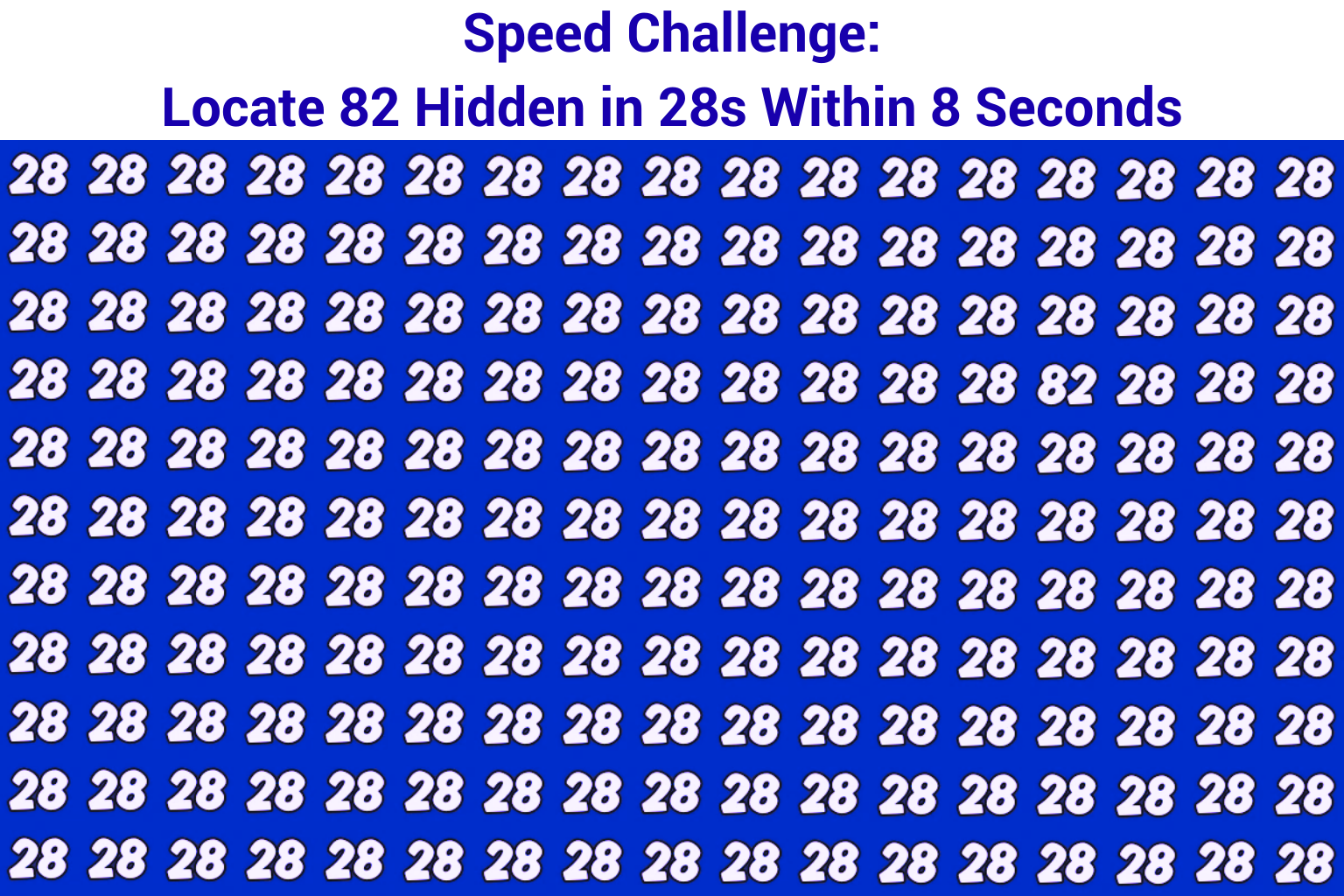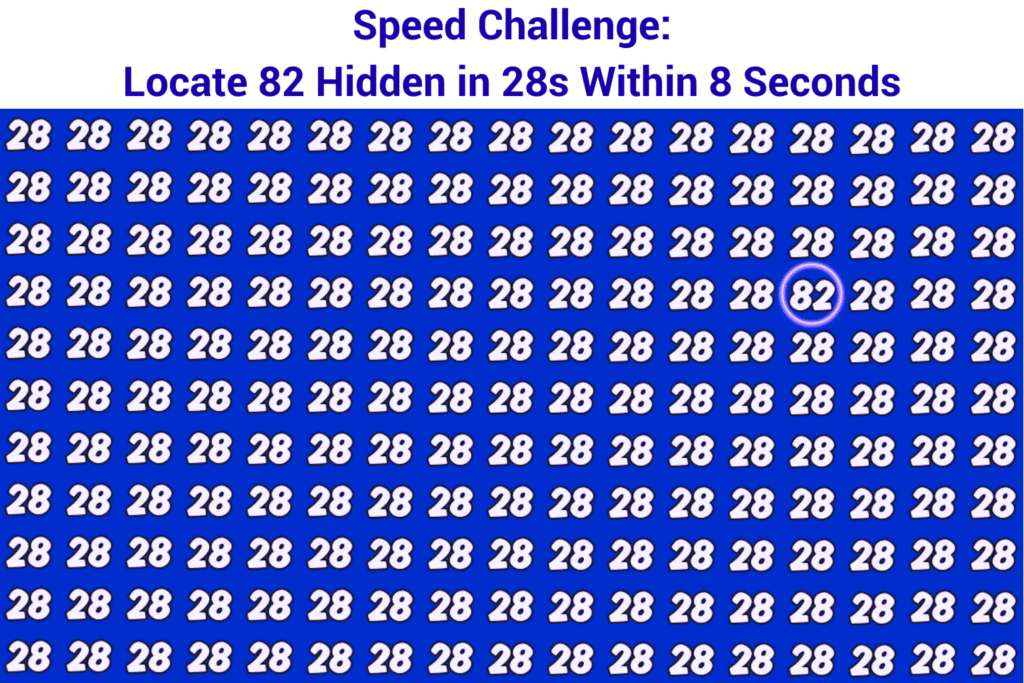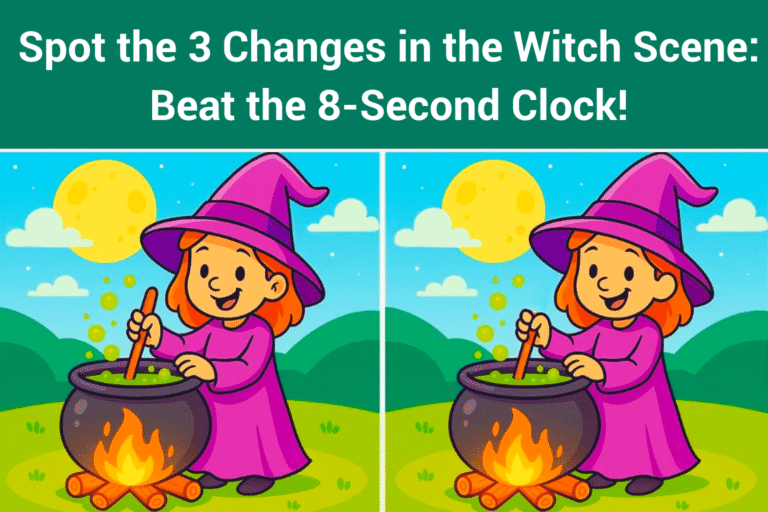
Ready for a quick brain-boosting challenge? This visual puzzle asks a simple question with a delightfully tricky twist: can 82 be found hiding in a grid packed with 28s—before the 8-second timer runs out? It’s fast, fun, and a surprisingly effective way to sharpen attention to detail.
Let’s break down what makes this challenge addictive, how to train the eyes to spot outliers faster, and where the hidden number likes to hide in puzzles like this one.

What Is “Observation Find It Out”?
“Observation Find It Out” is a bite-sized visual workout. Each challenge gives a crowded scene or number grid and asks for one thing: find the odd one out. Sometimes it’s a single letter lost among lookalikes; other times it’s a sneaky number that blends into a pattern. Add a countdown, and suddenly the heart beats faster, the eyes dart quicker, and the mind is fully engaged.
These quick visual drills are excellent for:
- Building focus and mental agility.
- Training the brain to process visual information rapidly.
- Strengthening pattern recognition and anomaly detection.
- Offering a stress-relieving break that still feels productive.
Today’s Challenge: Find 82 Among 28s in 8 Seconds
The setup seems simple: a grid filled with the number 28 repeated over and over. Hidden somewhere inside is one instance of 82. At a glance, everything looks uniform—exactly what the puzzle wants. Our brains love patterns; once they lock onto “28,” they tend to skim, auto-completing what they expect to see. That’s when 82 slips by unnoticed.
Why this feels tricky:
- The digits are the same, just reversed. That symmetry makes the disguise effective.
- Repetition dulls sensitivity. The more 28s you see, the easier it is to miss a tiny flip.
- Time pressure pushes the brain toward shortcuts, which favors the dominant pattern.
How to Outsmart the Pattern
If spotting the sneaky 82 feels tough, use these practical strategies:
- Scan by columns, not rows: Vertical sweeps reduce the tendency to “read” numbers as words and can reveal flipped pairs faster.
- Hunt for the “8” first: Train your eyes to catch the second digit. When your brain expects to see a “28,” a leading “8” can pop out visually.
- Break the grid into quadrants: Search top-left, top-right, bottom-left, bottom-right in sequence to avoid jumping around and missing sections.
- Use deliberate pace for 2 seconds, then accelerate: Slow scanning at the start locks your brain into “search mode,” making the final sweep faster and more accurate.
- Blink and refocus: A quick blink resets visual fatigue and helps reveal anomalies hiding in the noise.
Pro tip: If the font has similar forms for “2” and “8,” look for the inner spaces (counters) of the 8—they create a distinct shape compared to the diagonal of the 2.
Why These Puzzles Improve Focus
Beneath the fun is some useful cognitive training:
- Selective attention: Filtering out thousands of “28s” to catch one “82.”
- Visual discrimination: Noticing tiny differences in shape and order.
- Processing speed: Making accurate judgments under time pressure.
- Working memory: Holding the target (82) in mind while scanning.
Do a few of these challenges daily and the improvement becomes noticeable—not just in puzzles, but in everyday tasks like proofreading, reading dashboards, or spotting errors at work.
The Reveal: Where 82 Liked to Hide
In the original setup for this challenge, the hidden number was placed in the fourth row, fourteenth column—a spot far enough along to lull the eyes into autopilot. That’s a classic placement technique: bury the outlier deep in a repetitive flow to make the brain lean on expectation.
Even if a specific grid isn’t in front of you right now, remembering this common tactic will help in future puzzles:
- Middle-right or lower-middle zones are frequent hiding spots.
- Edge placements (first or last row/column) are rarer but great trick choices by designers.
- Reversal tricks (82 among 28s, 73 among 37s) are crowd favorites because they exploit symmetry.

Level Up: Try These Variations
Want to keep the momentum going? Create or look for challenges with these twists:
- Time squeeze: Cut the timer to 5 seconds.
- Crowd the grid: Increase the count of distractors (more 28s).
- Font shuffle: Use a typeface where similar digits look closer (adds difficulty).
- Dual target: Hide 82 and 88 among 28s—two different anomaly types.
- Color decoys: Use slight shifts in color or weight to mislead the eye.
If playing with kids or as a group, keep a scoreboard and rotate who sets the next challenge. You’ll be amazed at how quickly everyone gets sharper.
Troubleshooting: If You Keep Missing It
- Zoom your attention, not the image: Mentally “zoom” to a small block and finish it fully before moving on.
- Change the angle: Tilt your head slightly or view from farther back; the overall shape of 82 can jump out.
- Invert your search: Look for what 82 is not—scan for any number that doesn’t start with 2.
- Reset quickly: If you get stuck for more than 10 seconds, glance away for two seconds and return. The reset helps.
Why This Feels So Satisfying
That tiny jolt of victory when 82 finally pops into view is not an accident. The brain rewards pattern-break moments. They’re signals that attention, effort, and strategy paid off. It’s the same little spark that makes word searches, hidden-object games, and optical illusions irresistible.
Final Challenge
Set a timer for 8 seconds and imagine a 10×20 grid of “28” filling the screen. Commit to one method—column scans, quadrant sweeps, or “hunt the 8”—and stick to it. Even without the grid in front of you now, practicing the mental routine builds the muscle memory that pays off when you tackle the next puzzle.
And when 82 reveals itself? Enjoy that well-earned “found it!” moment. Then go again—short, playful bursts like this are one of the easiest ways to keep the mind sharp.
Ready for round two? Next time, try finding 73 hidden among 37s—with only 5 seconds on the clock.
FAQs: Observation Find It Out – Spot 82 Among 28s
- What is the main goal of this challenge?
The objective is to find a single instance of the number 82 hidden within a grid filled with 28s, ideally within 8 seconds. - Why is this puzzle harder than it looks?
The digits are the same but reversed (82 vs. 28). Repetition trains the brain to expect 28, so it unconsciously “autocompletes” and skips over the anomaly. - How can I improve my speed at spotting the 82?
Scan in columns rather than rows, divide the grid into quadrants, and consciously search for a leading 8 instead of a leading 2. Briefly blink and refocus if your eyes start to glaze over. - What skills does this puzzle strengthen?
Selective attention, visual discrimination, processing speed under pressure, working memory, and pattern recognition. - Is there a best place to start scanning?
Begin at a corner and move systematically, or use quadrant scanning (top-left, top-right, bottom-left, bottom-right). Consistency reduces missed spots. - Why use a timer (8 seconds)?
Time pressure heightens focus and reduces overthinking, turning it into a quick, engaging brain sprint. - I always miss it near the end—any tips?
Many puzzles hide outliers in the middle-right or lower-middle areas. If stuck, glance away for two seconds, then resume with a fresh scan path. - Can kids do this challenge?
Yes. It’s great for children’s concentration, number recognition, and visual tracking. Adjust the timer or grid size to match their level. - How often should I practice to see improvement?
Short sessions (2–5 minutes) a few times a week are enough to noticeably boost speed and accuracy over time. - What variations can make it more interesting?
- Reduce the timer to 5 seconds.
- Increase grid size.
- Mix similar targets (e.g., hide 82 and 88 among 28s).
- Change fonts or colors to raise difficulty.
- I find the font confusing—what should I look at?
Focus on the “8” counters (the two enclosed loops) versus the diagonal stroke of the “2.” The inner shapes of 8 are a quick visual hook. - How can this help outside of puzzles?
Improved attention to detail and faster visual processing carry over to proofreading, data checking, UI scanning, and everyday tasks that require spotting small inconsistencies.





